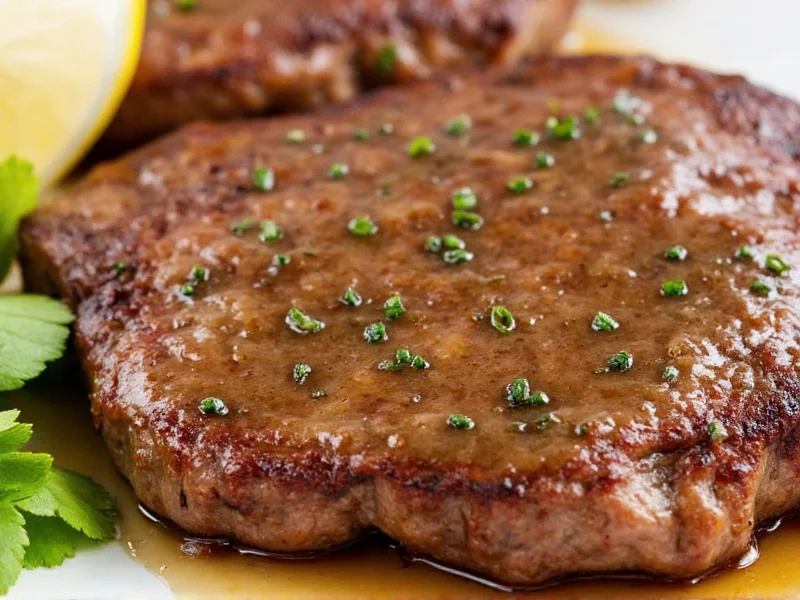Creating the perfect herb steak sauce requires understanding both ingredient chemistry and culinary technique. Unlike heavy cream-based sauces, herb steak sauce works by enhancing rather than masking the natural flavors of quality meat. The magic happens through the emulsion of high-quality olive oil with acidic components, which helps cut through the richness of steak while the herbs provide aromatic complexity.
The Science Behind Flavorful Herb Steak Sauce
Understanding the flavor compounds in herbs explains why certain combinations work best with steak. Rosemary contains camphor and 1,8-cineole, which pair exceptionally well with beef's fatty acids. Thyme's thymol content creates a savory depth that complements grilled meats, while parsley's apiole provides a clean finish that cuts through richness. When making homemade herb steak sauce, the order of ingredient incorporation matters significantly. Always add fresh herbs after removing the sauce from heat to preserve volatile aromatic compounds that would otherwise evaporate.
Classic Herb Steak Sauce Recipe
This professional-grade recipe yields enough sauce for four 8-12 ounce steaks. The key to exceptional flavor lies in ingredient quality and precise timing.
Essential Ingredients
- 1 cup extra virgin olive oil (choose a fruity Spanish or Italian variety)
- 3 tablespoons fresh lemon juice or red wine vinegar
- 2 tablespoons Dijon mustard
- 3 garlic cloves, minced
- 2 tablespoons fresh rosemary, finely chopped
- 3 tablespoons fresh thyme leaves
- 1/4 cup fresh flat-leaf parsley, finely chopped
- 1 teaspoon sea salt
- 1/2 teaspoon freshly ground black pepper
Preparation Method
- Combine olive oil, lemon juice, Dijon mustard, minced garlic, salt, and pepper in a glass bowl
- Whisk vigorously for 2-3 minutes until emulsified
- Allow the mixture to rest for 15 minutes to let flavors meld
- Fold in fresh herbs just before serving
- For best results, let the sauce sit at room temperature for 30 minutes before serving
Variations for Different Palates
While the classic preparation works for most applications, these professional variations address specific culinary needs:
- Mediterranean Style: Add 1 tablespoon capers and 1 teaspoon oregano for a briny, robust profile ideal for ribeye
- Asian Fusion: Substitute rice vinegar for lemon juice and add 1 teaspoon grated ginger for filet mignon
- Spicy Version: Incorporate 1 minced jalapeño and 1/2 teaspoon smoked paprika for skirt steak
- Creamy Alternative: Blend in 2 tablespoons Greek yogurt for a richer texture that works with leaner cuts
Optimal Steak Pairings
The right herb steak sauce can transform your dining experience when matched properly with different cuts. This professional pairing guide considers both fat content and texture:
| Steak Cut | Recommended Sauce Variation | Application Timing | Reasoning |
|---|---|---|---|
| Ribeye | Classic with extra rosemary | After resting | Rich marbling balances robust herbs |
| Filet Mignon | Lighter version with lemon zest | Before cooking | Delicate flavor needs subtle enhancement |
| Skirt Steak | Spicy variation | Marinate 2 hours | Penetrates tougher fibers effectively |
| Strip Steak | Mediterranean style | After cooking | Complements medium fat content perfectly |
| Flank Steak | Asian fusion | Marinate 4 hours | Acid helps tenderize leaner cut |
Storage and Shelf Life Considerations
Proper storage maintains both safety and flavor integrity. Fresh herb steak sauce keeps for 3-4 days in an airtight container in the refrigerator. For longer storage, freeze in ice cube trays then transfer to freezer bags for up to 3 months. Never store herb steak sauce at room temperature for more than 2 hours due to the risk of botulism from garlic in oil. When reheating frozen sauce, thaw overnight in the refrigerator rather than microwaving to preserve texture.
Common Preparation Mistakes
Professional chefs consistently avoid these critical errors when preparing herb steak sauce:
- Using dried herbs instead of fresh: Dried herbs have concentrated, different flavor compounds that don't provide the bright finish needed
- Adding herbs too early: Heat destroys delicate aromatic compounds in fresh herbs
- Imbalanced oil-to-acid ratio: Too much acid overwhelms the meat; too little fails to cut through richness
- Over-blending: Pureeing rather than finely chopping creates a muddy texture that doesn't cling properly
- Using low-quality olive oil: Inferior oils develop bitter flavors when combined with acid
Seasonal Ingredient Adjustments
Adapting your herb steak sauce recipe to seasonal availability ensures peak flavor. In spring, increase parsley and add chives for a brighter profile. Summer allows for basil additions that complement outdoor grilling. Fall calls for heartier herbs like sage and oregano that pair well with richer dishes. Winter versions benefit from preserved ingredients like lemon zest and dried herbs when fresh options are limited. Always adjust acid levels seasonally—use more in summer when flavors are brighter, less in winter when richer profiles dominate.











 浙公网安备
33010002000092号
浙公网安备
33010002000092号 浙B2-20120091-4
浙B2-20120091-4